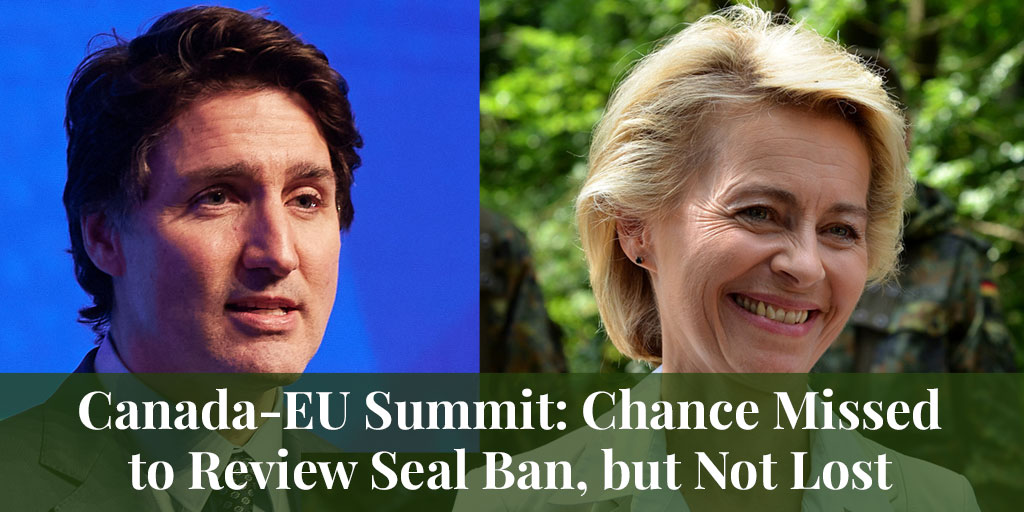Canada-EU Summit: Chance Missed to Review Seal Ban, but Not Lost
by Doug Chiasson, Executive Director, Fur Institute of CanadaOn Nov. 23-24, all the right people – leaders from the European Union and Canada – were gathered in St….
Read More

On Nov. 23-24, all the right people – leaders from the European Union and Canada – were gathered in St. John’s for the Canada-EU Summit. Those of us representing Canadians who make their livings in remote and rural areas from Prince Rupert to Newfoundland’s outports, by harvesting fur and seals, were hopeful. Meetings such as these provide high-level government representatives with an opportunity to discuss issues that matter to their respective governments behind closed doors and far removed from everyday citizens.
And, this summit was different. Instead of being monitored only by political gadflies and lobbyists, people in remote communities across Eastern and Northern Canada watched closely. They watched because the summit was held in Newfoundland, where the ocean and its bounties have long been the bedrock of the economy and culture.
This, of course, is the same St. John’s that once was home port to steamers, which brought hundreds of Newfoundlanders to the ice of the North Atlantic to harvest seals. The same St. John’s where European celebrities descended to hold press conferences in front of TV cameras to attack the livelihoods of hunters who put their lives on the line on the ice to provide for their families. The same St. John’s where, for over 30 years, the elected officials of the provincial government sat on sealskin chairs as they debated the business of the day.
In 2009, the predecessors of those same EU officials who were fêted in St. John’s banned the trade of Canadian seal products, striking a blow to rural communities across Eastern and Northern Canada that had relied on the hunting of seals for hundreds of years. Regulation No 1007/2009 inflicted untold damage not only to communities in Newfoundland and Labrador and Quebec, but also to Inuit communities across Canada’s North.
The impact on Inuit communities was the genesis of a challenge to the ban in the European Court of Justice, brought by Inuit Tapiriit Kanatami and supported by the Fur Institute of Canada and others. This was followed by a challenge by the Government of Canada at the World Trade Organization. Though it upheld the ban, the WTO challenge forced the EU to allow an exemption for seals harvested by “Inuit and other Indigenous communities”.
This is the exemption that European Commission President Ursula von der Leyen said was “working well” and that a “good balance” had been found on seals. This is completely and unambiguously false. Only two bodies in Canada are recognized as being able to certify that a seal product comes from an Indigenous harvest: the Government of Nunavut and the Government of Northwest Territories. In a report from her own Commission, it shows that Nunavut has only exported two sealskins to Europe, in 2020, and the Northwest Territories exported just two sealskin coats, in 2022.
European Sealers Also Hamstrung
Perhaps even more revealingly, that same report contains four EU member states saying that the ban’s “impact has gone beyond its intended purpose”. These four states – Estonia, Latvia, Finland and Sweden – all still have their own seal hunts but are hamstrung the same way Canadian sealers are when it comes to trading their products.
In terms which would be shockingly familiar to anyone on Canada’s East Coast, these states raise concerns about the impacts of seals eating cod and salmon, about infecting fish with parasites, and impacts on commercial and recreational fisheries.
Unfortunately, EU and Canadian officials did not avail themselves of an ideal opportunity to reverse the historic injustice of the 2009 seal ban when they gathered in St. John’s.
But it’s not too late. The European Commission is launching a review of the Regulation on Trade in Seal Products in 2024. Canada can, should, and must work closely with the EU member states that are unhappy with the ban, supported by Canada’s sealing industry and Indigenous leadership, to overturn the regulation.
We also need European Commission leadership to engage honestly and candidly on the damage done by this ban and chart a course to move beyond the mistakes of the past. This conversation must be elevated to the most senior levels and involve representatives of the industry and Indigenous communities directly impacted, not the extremist animal-activist groups whose goal is to destroy the way of life of people who live close to the land – and sea – and who use renewable natural resources responsibly and sustainably..







